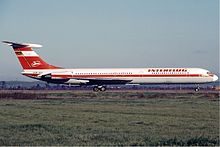This article has multiple issues. Please help improve it or discuss these issues on the talk page. (Learn how and when to remove these messages)
|
 An Interflug Il-62, similar to the one involved in the crash An Interflug Il-62, similar to the one involved in the crash | |
| Accident | |
|---|---|
| Date | 14 August 1972 |
| Summary | In-flight fire leading to mid-air breakup |
| Site | Near Königs Wusterhausen, Bezirk Potsdam, East Germany 52°18′23″N 13°41′19″E / 52.30639°N 13.68861°E / 52.30639; 13.68861 |
| Aircraft | |
| Aircraft type | Ilyushin Il-62 |
| Operator | Interflug |
| IATA flight No. | IF450 |
| Call sign | INTERFLUG 450 |
| Registration | DM-SEA |
| Flight origin | Berlin-Schönefeld Airport, Schönefeld, East Germany |
| Destination | Burgas Airport, Burgas, Bulgaria |
| Occupants | 156 |
| Passengers | 148 |
| Crew | 8 |
| Fatalities | 156 |
| Survivors | 0 |
The 1972 Königs Wusterhausen air disaster occurred on 14 August when Interflug Flight 450, an Ilyushin Il-62, crashed shortly after take-off from Berlin-Schönefeld Airport in Schönefeld, East Germany, on a holiday charter flight to Burgas, Bulgaria. The accident was caused by a fire in the aft cargo bay which spread quickly, destroying the aircraft’s structural integrity. All 156 passengers and crew died. To this day, it is the deadliest aviation accident to occur on German soil.
Aircraft and crew
The aircraft was a Soviet-built Ilyushin IL-62 aircraft, registered DM-SEA, powered by four Kuznetsov NK-8 engines. It first flew in April 1970, and up until the accident had acquired 3,520 flight-time hours.
The aircrew consisted of 51-year-old captain Heinz Pfaff, 35-year-old first officer Lothar Walther, 32-year-old flight engineer Ingolf Stein, and 38-year-old navigator Achim Flilenius. The flight crew members had 8,100, 6,041, 2,258, and 8,570 hours of experience, respectively.
Crash
Interflug flight IF450 left Berlin-Schönefeld Airport at 16:30 local time. Because of the summer holiday, the number of passengers – mainly tourists bound for the Bulgarian Black Sea Coast – almost reached the full capacity of the airliner. Takeoff proceeded normally, and the aircraft then headed southeast towards Czechoslovakia, now the Czech Republic.
At 16:43, thirteen minutes into the flight and 8,900 metres (29,200 ft) above the city of Cottbus, East Germany, the crew reported problems with the elevator; the aircraft was by this time approximately 10 degrees off its designated route. The flight requested a return to Schönefeld but did not think the situation critical enough for an immediate landing at the nearest airport. At 16:51, the crew carried out a fuel dump to decrease landing weight. Meanwhile, flight attendants reported smoke in the rear section of the cabin. With Berlin-Schönefeld Airport already in sight a few kilometres south, the flight issued a mayday at 16:59:25, indicating problems controlling the aircraft's altitude. At this time, the flight crew was likely unaware that the fire had been consuming portions of the rear of the aircraft. A few seconds later, the tail section, weakened by the fire, separated from the aircraft, causing it to enter an uncontrolled descent. Due to the forces of the dive, the rest of the aircraft broke up in mid-air, the debris landing in the town of Königs Wusterhausen, East Germany.
Cause

The pilot's last messages suggested that a fire in the rear of the aircraft was responsible for the accident. This part of the aircraft was not accessible from the cabin and had no smoke detectors, so the crew was unable to immediately grasp the severity of the situation. The fire was caused by a hot-air tube leak, through which air heated to some 300 °C (570 °F) escaped, damaging the insulation of electrical wires and the aircraft flight control system. After takeoff, the resulting short circuit caused 2,000 °C (3,600 °F) sparks, lighting a fire in Cargo Bay 4. The fire then spread until smoke reached the passenger cabin and the fuselage was weakened. Ultimately, the tail section failed in flight.
Memorial
At the Wildau Cemetery, close to Königs Wusterhausen, a memorial commemorates the victims whose names are written on a black stone marker.
See also
References
- Denes, Benjamin; Spaeth, Andreas (13 August 2022). ""Mayday! Kurs 90 Grad, unmöglich Höhe zu halten."" ["Mayday! Course 90 degrees, impossible to maintain altitude."]. Berlin-Brandenburg Broadcasting (in German). Retrieved 14 August 2022.
- "156 Are Killed in Air Crash In a Suburb of East Berlin". The New York Times. Vol. 121, no. 41842. 15 August 1972. ISSN 0362-4331.
- "Stotterndes Geheul" [Stuttering howl]. Der Spiegel (in German). Spiegel-Verlag. 21 August 1972. Archived from the original on 5 November 2013.
- Ranter, Harro. "Accident Description". Aviation Safety Network. Flight Safety Foundation. Retrieved 18 May 2020.
- "East Germany Says Blast Led to Crash Fatal to 156". The New York Times. Vol. 121, no. 41843. 16 August 1972. ISSN 0362-4331.
External links
- Entry at aviation-safety.net
- www.interflug.biz
- Haine, Edgar A. (2000). Disaster in the air. Associated University Presses. p. 123. ISBN 978-0-8453-4777-5.
| Aviation accidents and incidents in Germany | |||||||||
|---|---|---|---|---|---|---|---|---|---|
| German Empire (1871–1918) |
| ||||||||
| Nazi Germany (1933–1945) |
| ||||||||
| Occupied Germany (1945–1949) |
| ||||||||
| West Germany and West Berlin (1949–1990) |
| ||||||||
| East Germany (1949–1990) |
| ||||||||
| Germany (1990–) |
| ||||||||
| Aviation incidents that took place in West Berlin, or involved an approach for there, are marked with an asterisk (*). | |||||||||